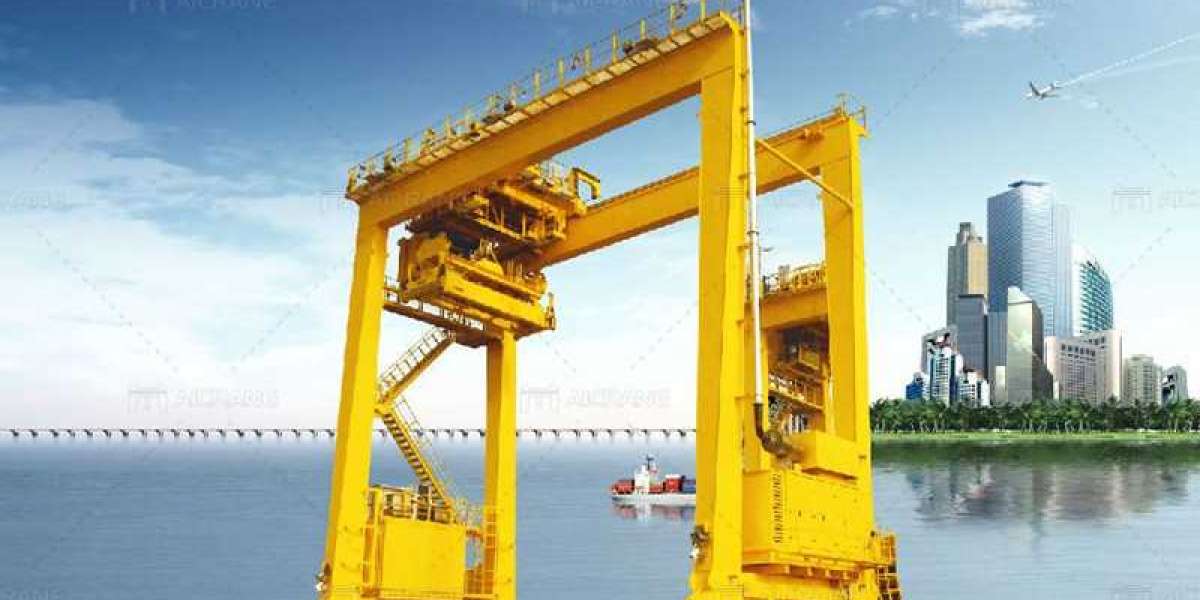Gantry cranes are essential components of modern container ports, facilitating the movement of cargo from ships to trucks, trains, and storage yards with incredible efficiency. Specifically designed for handling containers, these cranes are known as container gantry cranes or ship-to-shore cranes, and they operate by lifting, moving, and placing containers in their designated locations.

The process of container handling by a gantry crane at port involves several steps, including the alignment of the crane with the container ship, attaching to the containers, lifting, transporting, and safely placing the containers onto the intended destination. This passage will explain how gantry cranes at ports handle containers, the technology and mechanics behind their operations, and the importance of safety and precision.
Structure and Function of a Gantry Crane at Port
A typical gantry crane at port is a large, towering structure capable of moving along rails that are positioned parallel to the dock. These cranes consist of several key components that are crucial to their operation:
Main Girder: The horizontal beam that spans the width of the port and is responsible for holding the lifting mechanism.
Trolley: A movable platform that runs along the length of the main girder. The trolley holds the hoist and is responsible for lifting and moving containers horizontally.
Hoist: The lifting mechanism equipped with a specialized spreader, designed to attach to the top of containers securely.
Legs: Vertical supports that rest on wheels and allow the crane to move along rails positioned parallel to the dock. The legs provide the necessary height and stability for lifting containers from ships.
Spreader: A key component in container handling, this device attaches to the four corners of a container and locks securely, ensuring that the container is safely lifted and transported.
Step-by-Step Process of Handling Containers at Port
1. Aligning the Gantry Crane with the Container Ship
When a container ship arrives at the port, the first step in the container handling process involves aligning the gantry crane with the container bay of the ship. The crane operator, from a cab positioned at the top of the crane, uses advanced systems, such as cameras and sensors, to ensure that the crane is correctly aligned with the containers that need to be unloaded.
Precise Positioning: The operator must position the crane with accuracy to avoid any damage to the ship or containers. Once aligned, the trolley carrying the spreader is moved into place over the container.
2. Attaching the Spreader to the Container
Once the crane is properly positioned, the operator lowers the spreader toward the container. The spreader has adjustable arms or twist locks that latch onto the four corners of the container. These locks ensure that the container is securely attached to the crane.
Locking Mechanism: Modern spreaders are equipped with electronic controls that indicate whether the container is securely locked in place. Once the locks are engaged, the operator receives a signal confirming that the container can be lifted.
3. Lifting the Container from the Ship
With the spreader securely attached, the hoist mechanism is engaged to lift the container from the ship. The lifting process must be smooth and steady to avoid any swinging or tilting of the container.
Hoisting Speed: Gantry cranes at ports are engineered to lift heavy containers efficiently, typically weighing up to 40 tons for a standard 40-foot container. The hoist speed can vary depending on the type of crane and container weight, but it is critical that the lift be controlled and stable.
Balancing the Load: Throughout the lifting process, the operator must ensure that the load remains balanced to prevent accidents. If the container is not properly centered, it may shift or sway, which can be dangerous.
4. Moving the Container Along the Gantry Crane
Once the container is lifted to the appropriate height, the trolley mechanism moves the hoist and container horizontally along the gantry crane's main girder. The operator directs the trolley toward the container’s designated destination, which could be a storage area, truck, or rail car.
Transporting the Load: Depending on the port’s layout, the container may need to be transported over a considerable distance. This movement requires the crane to be both flexible and stable, as sudden shifts in speed or direction can cause the container to swing.
5. Placing the Container
After reaching the destination, the operator carefully lowers the container into position, whether onto a truck, train, or a stack of other containers in the port yard. The spreader’s locking mechanism is released, allowing the container to detach safely.
Precision and Safety: The final placement of the container must be done with extreme precision. In busy port environments, containers are often stacked tightly together, and even a minor misalignment can cause disruptions or accidents.
Releasing the Container: Once the container is securely placed, the spreader’s locks are disengaged, and the crane operator can lift the hoist and prepare for the next container.
Technology Used in Container Gantry Cranes
Modern gantry cranes at ports are equipped with various technologies that enhance their efficiency and safety:
Automated Systems: Many port cranes use automated systems for positioning and load balancing, reducing human error. These systems use sensors, cameras, and computer algorithms to assist operators in safely lifting and moving containers.
Anti-Sway Technology: To prevent containers from swaying during transport, gantry cranes are equipped with anti-sway technology. This helps ensure that containers move smoothly and are placed accurately.
Remote Operations: Some ports are adopting remote-controlled cranes, allowing operators to manage the crane from a control room. This approach improves safety and increases operational efficiency by reducing the need for on-site operators.
Importance of Safety in Container Handling
Handling containers at ports involves significant safety risks due to the size and weight of the loads. Ports must adhere to strict safety standards to prevent accidents, injuries, and damage to cargo. Key safety practices include:
Regular Maintenance: Gantry cranes must be regularly inspected and maintained to ensure all mechanical parts are functioning correctly. Any issues with the hoist, spreader, or trolley system could lead to accidents.
Training for Operators: Crane operators require extensive training to handle gantry cranes efficiently. They must understand how to control the crane’s movements, manage load balance, and react to potential hazards.
Safety Protocols: Ports must establish safety protocols for crane operations, including guidelines for communication between the crane operator, ground workers, and other port personnel.
The gantry crane at port plays a critical role in the efficient and safe handling of containers. From aligning with the ship and attaching the spreader to lifting and placing containers, each step in the process requires precision and control. Modern technology, such as anti-sway systems and automation, helps improve the safety and speed of operations, while skilled operators ensure that containers are handled without incident.
By adhering to safety protocols and utilizing advanced technologies, ports can optimize the use of gantry cranes, ensuring that goods are moved swiftly and securely through the global supply chain.







